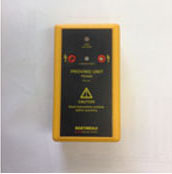 This is a proving unit. If your voltage tester does not have a self-test feature you need to prove that your voltage tester is working after you have tested for dead. This can often be difficult as you have just isolated the circuit and testing a known live circuit means that you often have to locate another live circuit so a proving unit is used to confirm that your tester is working. These units are often expensive and so it often works out much cheaper to buy a GS38 approved voltage tester with a built in test function. This is a proving unit. If your voltage tester does not have a self-test feature you need to prove that your voltage tester is working after you have tested for dead. This can often be difficult as you have just isolated the circuit and testing a known live circuit means that you often have to locate another live circuit so a proving unit is used to confirm that your tester is working. These units are often expensive and so it often works out much cheaper to buy a GS38 approved voltage tester with a built in test function.
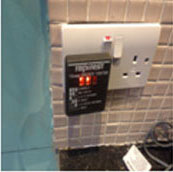 Here we have a faulty socket that requires repairing, as you can see there is a socket tester plugged into the socket but you cannot trust this for testing for dead as there is a chance that the socket tester will stop working at some point. Here we have a faulty socket that requires repairing, as you can see there is a socket tester plugged into the socket but you cannot trust this for testing for dead as there is a chance that the socket tester will stop working at some point.
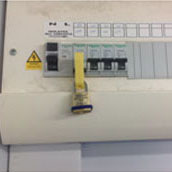 Locate the appropriate MCB in the consumer unit and then switch it off. Locate the appropriate MCB in the consumer unit and then switch it off.
It is important to make certain that nobody can restore the power when you are working on the circuit so it must be locked off using an appropriate locking off device. When the circuit is locked off ensure that you keep hold of the key!
If you have a fuse box you will need to remove the fuse to the circuit. Most fuses will be labeled up, so you can switch off the consumer unit and remove the fuse to the circuit that you are working on. You should keep the fuse on your possession so that nobody can restore the power to the circuit that you are working on. A sign should also be placed on the consumer unit warning people that you are working  on the circuit. on the circuit.
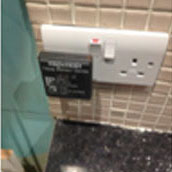 Now you will notice that the socket tester is no longer illuminated, but the tester could be faulty so before touching any potentially live parts you need to test using the GS38 approved voltage tester. Now you will notice that the socket tester is no longer illuminated, but the tester could be faulty so before touching any potentially live parts you need to test using the GS38 approved voltage tester.
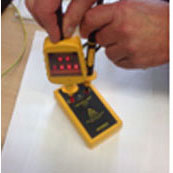 Before using the tester confirm it is working by either using the self-test function, testing it on a known live source or by using a proving unit. Before using the tester confirm it is working by either using the self-test function, testing it on a known live source or by using a proving unit.
If the test was successful on the tester, you can remove the fixing screws from the socket, and perform the test to confirm that there is no voltage present at the terminals at the socket.
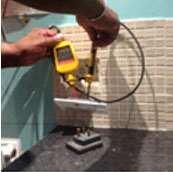 If the test was successful and the tester did not find any voltage you just need to test the tester is working again by either using the self-test function or by using the proving unit. If the test was successful and the tester did not find any voltage you just need to test the tester is working again by either using the self-test function or by using the proving unit.
 Then you can repair the faulty socket. Then you can repair the faulty socket.
If in any doubt contact a competent person in your area
http://www.electricalcompe tentperson.co.uk/ |